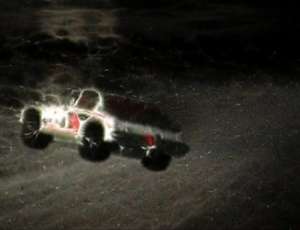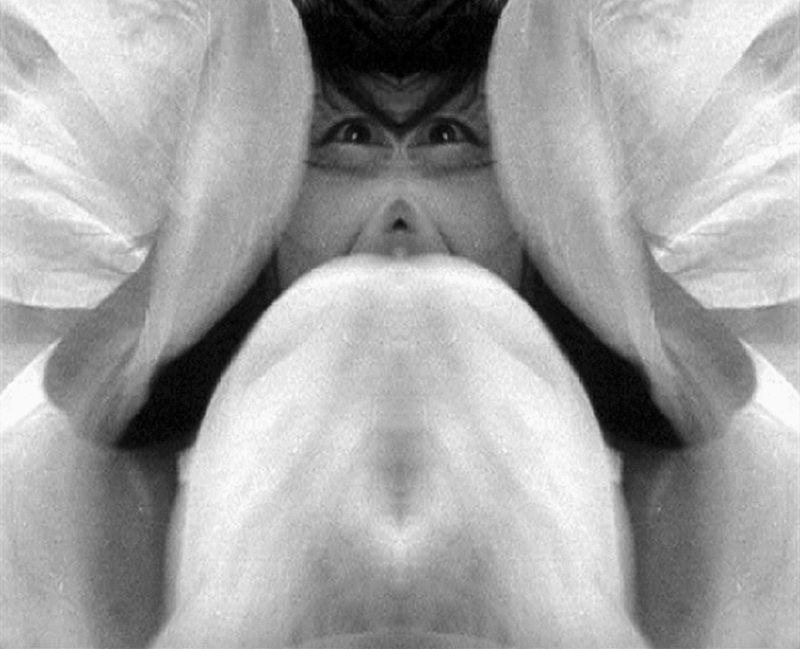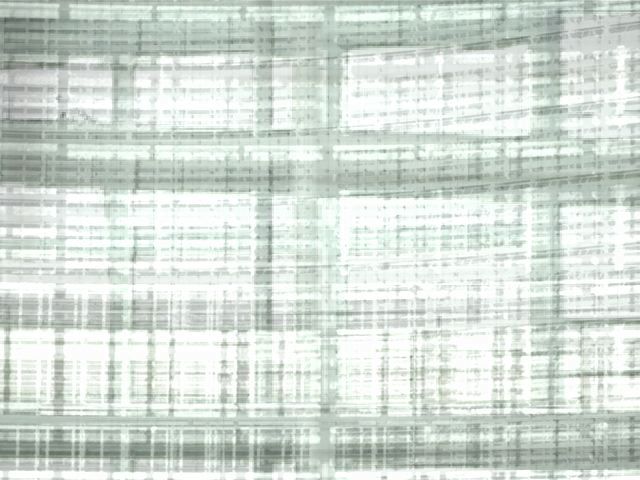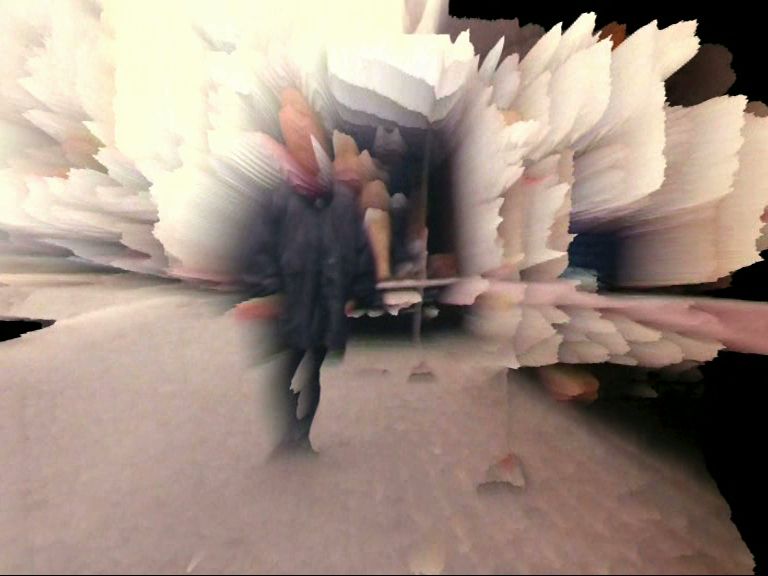Audio Visions - Dissonanze 6, Festival di Musica Elettronica e Arte Digitale

Dissonanze is an international festival of electronic music and digital art, based in Rome. The festival program explores the relationship between creativity and technology, looking for unknown correspondences among visual, sonory and urban universes and phantasies. The program of the 6th edition lists performances by such artists as Zbignew Karkowski, Yasunao Tone, Carl Michael Von Hauswollf, Olivia block, Maryanne Amacher and Francisco Lopez. This year there is a focus on the concept of "visual music". argos was invited to compose a program, based around the relationship between electronic sound and image. The program will be shown in the Aula Magna of the ’Palazzo dei Congressi’, alongside performances by artists like Jeffers Egan, Karl Kliem/Dienstelle, Purform, Ryoichi Kurokawa, Stephen Vitello and Steve Roden.
The development of electronic and digital media technology has made it possible to move image and sound beyond the limitations of "real" time and space. The use of music, as a configuration of uprooted and generated sound patterns, is significant in this respect: not only does music liberate us from the actual listening time, the image also drags itself away of the linearity which is imposed by actual sound or dialogue. The image escapes from its status of relatively stable visual surface and recovers its full meaning (again) in movement and texture. It turns in something to listen to. We hear what we see, we see what we hear.
The digital media bring image and sound closer together: in the same way sounds are edited it is possible to compose with images. Image and sound turn into data, which, once translated by software, can be moulded and layered more and more intuitively. A generation of sound and image makers, who grew up with the inheritance of the avant-garde, always surrounded by sound and image, are looking for diverging ways of representation and interpretation, away from the narrative straitjacket, from the illusion of continuity and coherence. It is a generation which grew up with a permanent and constantly evolving presence of the audiovisual: the rhythm accelerations in the editing, the turn from film to video, the aesthetical exchange between cinema and television, the visual and auditive polyphony of MTV-culture. A generation gladly subjecting itself to a flood of images and sound, gradually replacing reality, not merely existing outside us, but inside of us as well.
The makers in this programme move freely between abstraction and narrative, between identifiability and alienation. They create self-enclosed audiovisual and musical worlds, typified by repetition, distortion and suggestion, averse to eccentric meaning. Image and sound sling around one another, still they are separate, asynchronous but inextricably bound in a continuous game of attraction and repulsion. Movement is structured, time is sublimated. Image and music resonate in and between one another: cyclic, plastic, ambiguous, musical, affectionate. In-between lurks an imaginary vacuum, hiding unnamed meanings and metaphors. These are encounters feeling like indefinable whims of the human existence, as lighting beacons amidst a shroud of memories. Timbre and colour, tone and texture, pitch and rhythm: various languages, various trajectories, a transcendental experience.
Kurt D’Haeseleer
Fossilization
2005, col., 9’, music/sound: David Shea
This video was produced as part of the ’Memory Lane’ project, commissioned in 2005 by the International Film Festival Rotterdam. The traditional idea of soundtracks as translation and extension of moving images was reversed for the occasion: five video makers were requested to produce a work based on a composition by David Shea. Each individual filmmaker could draw out his own trajectory throughout the various musical layers. D’Haeseleer merged sound with image into an immersive panorama of fossilised shapes and traces. Images were distorted, layered and shaped into an apocalyptic spectacle in which vaguely recognisable shades and objects seem to be sucked up, into a parallel, enamelled world. Underneath all of these hermetical levels Fossilization comes forward as a meditation on the slip-off of Western civilisation to a pandemonium of mass-tourism, -media and –consumption.
Guillaume Graux & Frederik Van Allemeersch
In Leisure
2003, col., 14’, music/sound: Tuk, Ovil Bianca, Köhn
Through a succession of overly romantic images of everyday relaxation rituals a link is made between recreation and spectacle. Where does tourism end and where does voyeurism begin? The sensation of watching, of looking at, conditioned and determined in the arenas of television and other communication technologies, is exposed in an aesthetics which atmospherically refers to the soap opera. A slow and telescopic image haze strides by on the tones of cloying muzak and ethereal electronic sound images. This video was composed as a first draught for the music of Tuk, Köhn and Ovil Bianca, on the occassion of the .wav festival in bruges.
Nicolas Provost
Papillon D’Amour
2003, col., 3’30", music/sound: Köhn
The work of Nicolas Provost balances between fiction and experiment, the grotesque and the moving, and it provokes both recognition and alienation. He blends in all kinds of narrative clichés, film samples and various cinematographic styles into tiny phantasmagorias. Time and again these succeed in catching our expectations into an unravelling game of mystery and abstraction. In most videos filmic memory is stimulated by short fragments from classic films by Akira Kurosawa or Alain Resnais, but Provost is as likely to appropriate snippets from obscure B-films or thematic platitudes. With the help of various simple graphical effects, manipulations of time and form, cinematographic and narrative language is analysed, accents are shifted and new stories are told. The extraordinary is elucidated in order to reveal the global. Apart from the use of film and visual language music is also a constant factor in Provost’s body of work, as a rhythmical spine or an emotional guideline. In Papillon D’Amour, Provost subjects a number of fragments from a film by Kurosawa to a mirror effect, thus creating ethereal figures, constantly remelting into each other and slipping away again. The “imploding butterfly” is metaphoric for the impossibility of love.
Pascal Baes
HF Remix
2002, col., 11’30", music/sound: DJP
HF Remix 1 is a mathematical ’re-cookery’ of fragments of old 16mm films through the systematic adaptation of the ’Height Field’ effect on images. The film Rainbow market shows a series of performances carried out at the Centre Pompidou in Paris and at the Sint-Gilles’ flower market in Brussels. The images have been digitally enhanced frame by frame with the ’Height Field’-effect, boosting the grey values to their black and white extremes. The end-result is 3D images creating an explosion of light and colour. Highly accelerated and compressed musical fragments by DJP accompany the images.
Anouk de Clercq & Joris Cool
Building
2003, col. 12’, music/sound: Anton Aeki
Shafts of light and the camera are moving through the dark as in a glissando, flat, sharply cut forms appear in black-and-white and high definition. They feel their way along expanses of wall, opening up storeys, windows and doors, and break down on floors, stairs and columns. In this way, according to a controlled choreography upheld by the music of anton aeki, a truly architectural experience is created on the screen. like a constructivist audiovisual mobile, the building reveals itself and is being documented as in an architect’s dream. in other words: as a spatial and atmospheric starting point for users to start leaving their marks on it. Building is inspired by the new concerthall in bruges and thereby also pays homage to the work of Robbrecht and Daem, the Belgian architects’ collective which is well known for such exploits as the new Boymans van Beuningen museum in Rotterdam and the aue-pavilions for Documenta IX in Kassel.
Justin Bennett
Berlaymont Dreaming
2004, col., 20’20"
A video/surround-sound piece made for the argos Festival 2004. "The Berlaymont building, seat of the European Commissionis a symbolic centre for the European quarter of Brussels as well as for Europe itself. Formally interesting is the fact that the original modernist architecture has been renovated and forseen with a new "skin" or rather an armour plating,changing the outward appearance while preserving the inner form. I see this as mirroring the expansion of Europe in general. Berlaymont/Europe is pictured as a modernist utopia, where the transparency of architecture is a metaphor for democracy itself. The building is empty, but it hums softly to itself. It dreams of its future uses, its future occupants, dreaming that it might one day be open to all, but knowing that its gigantic security machine regulates the flow and access of people just as the airconditioning regulates the flow of air and heat.The sounds are of empty buildings and their machines but sometimes other sounds filter in from outside through ducts or through the windows. The images are of Berlaymont and other buildings either in use or already being demolished.The image and sound sequences are composed by a machinethat chooses sounds and images which build up, overlap and then fall away again. Thus the machine constructs its "dreaming"- an imaginary ephemeral architecture".
Palazzo dei Congressi, Roma



